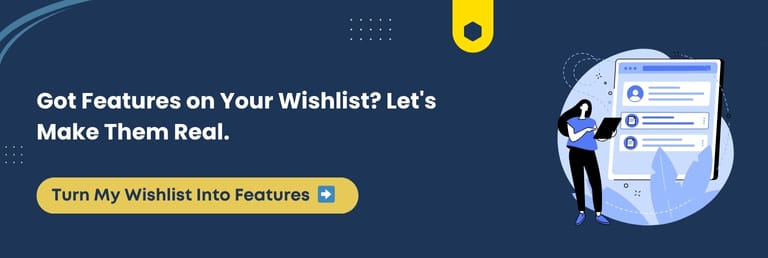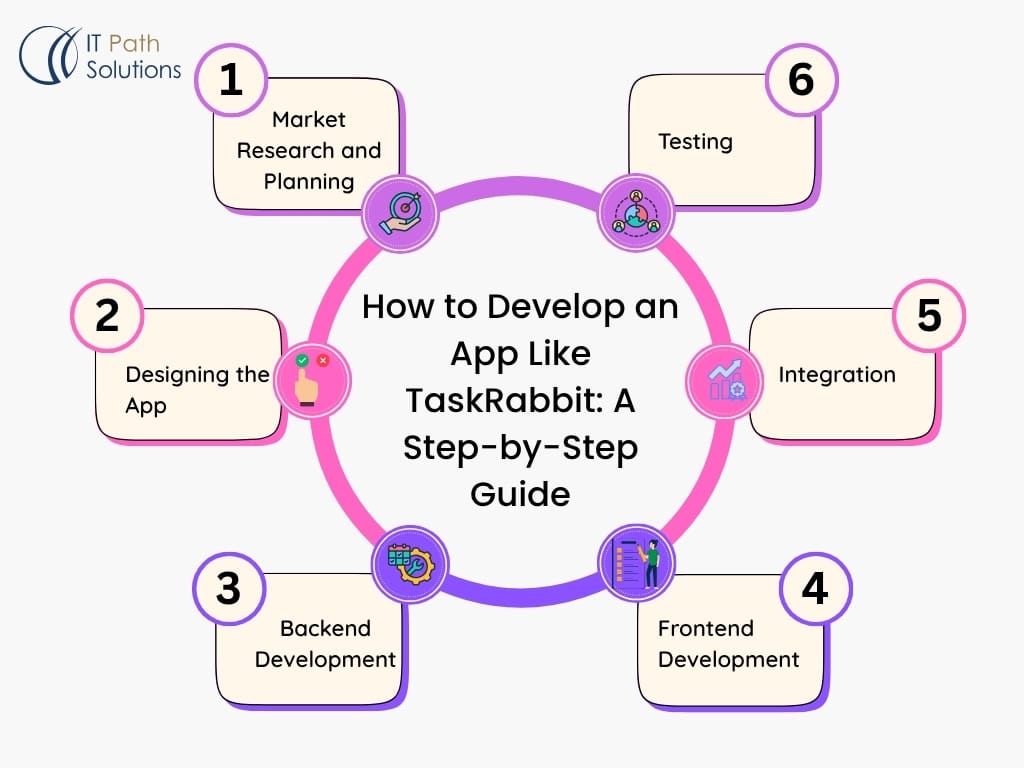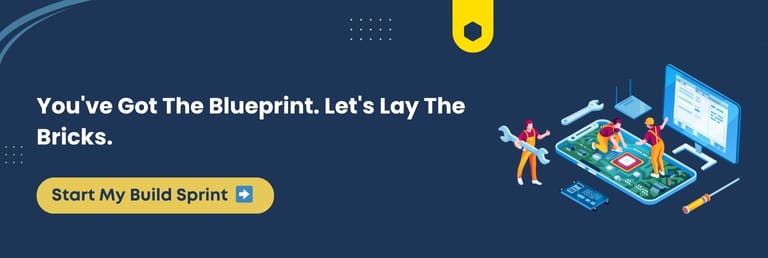Build An App Like TaskRabbit: Cost, Steps, And Alternatives Explained
Keyur Patel
September 12, 2025
26 min
Imagine this: A busy professional moves into a new city and needs a reliable handyman within the hour. A senior citizen wants someone to help with groceries, but doesn’t know where to start. A working parent is overwhelmed with everyday tasks and just needs one thing off their plate.
Each of these real-life moments creates demand, and platforms like TaskRabbit have been turning that requirement into an opportunity for over a decade.
But here’s the catch: Though TaskRabbit may have pioneered the model, the market is evolving rapidly than ever. New users want more trust, quicker matches, lightning-fast payments, and superior local options. And that is precisely where your opportunity lies.
Hence, we have designed this blog not only to spotlight how TaskRabbit works or identify its competitors but also to show you how you can build something better. This blog is your blueprint to turn your vision into a growth-friendly, profitable business.
Whether you’re a startup founder, a digital product leader, or an entrepreneur exploring the on-demand economy, this guide will walk you through everything from features and tech stack to development costs and monetization strategies.
You’ll learn how to build an app like TaskRabbit and how to position it for growth in 2025 and beyond.
Let’s get started!
Why The World Needs Another TaskRabbit And Why You Could Build It
Every day, millions of people search for someone to fix a leaky faucet, assemble furniture, or walk their dog. They don’t want to wait. They want it done today, maybe even now. The world is asking for more options, top-notch service, swift results, and local trust.
Imagine a city where residents rely on a single outdated service platform that is either unavailable in their neighborhood or does not offer the task category they need. You launch an app to solve these challenges.
People in your area start booking help. Local taskers finally get fairer pay and consistent work. Word spreads. You become the go-to app in your community.
It is not an overstatement; it is a market reality.
Search data shows a sharp increase in phrases like “TaskRabbit alternatives,” “handyman app,” and “apps like TaskRabbit.” People are actively looking for superior or more localized solutions.
It opens the door for innovators ready to solve everyday problems with advanced technology, better matching, and exceptional user experiences.
So, why build an app like TaskRabbit now?
- The on-demand services economy is booming, with billions flowing into home services, errands, and gig-based work.
- People want personalized, local, and transparent service experiences.
- Many markets remain underserved or poorly supported by existing platforms.
- Launching an app today does not require a massive team or endless funding. With pre-built platforms, APIs, and experienced development partners, you can go from concept to market more quickly than ever before.
It is your opportunity to create a spectacular, more focused, and more trustworthy alternative to TaskRabbit.
Whether you’re targeting a specific service niche, a local market, or building something broader, the demand is ready. The tools are available.
Next, let us understand what TaskRabbit is and how it works, so you can start thinking strategically about what to replicate, improve, or completely reimagine.
What Is TaskRabbit And How Does It Work?
TaskRabbit is an on-demand service marketplace that connects users with local freelancers for help with household tasks, repairs, and everyday errands.
Whether someone needs a hand assembling IKEA furniture, moving heavy items, or deep-cleaning a home, TaskRabbit acts as the digital bridge between those with tasks and those offering services.
Launched in 2008, the platform has grown to support users across top cities globally, offering access to vetted “Taskers” who can accept and complete jobs directly from the app. For users, it provides convenience and reliability. For Taskers, it offers flexible income opportunities and a steady stream of gigs.
The basic functionality of TaskRabbit revolves around a simple interaction between a client and a service provider, streamlined within an app environment.
Here is how TaskRabbit works step by step:
- Account Creation: Users and taskers both create their profiles. Users provide task details and locations. Taskers verify their identity, select services they can provide, and set their hourly rates.
- Task Posting: A user submits a task request with preferred timing, location, and other relevant details. It may include specific instructions or material requirements.
- Matching and Bidding: The app matches the task with qualified Taskers based on location, availability, and service category. Some Taskers may respond by bidding or offering instant acceptance.
- Communication: Once a task is accepted, the user and Tasker can chat within the app to clarify expectations or coordinate timing.
- Task Completion and Payment: After the task is completed, payment is processed automatically within the app. Users can tip Taskers and leave ratings.
- Ratings and Reviews: Both parties are encouraged to rate the experience. This feedback loop is vital to building trust and platform growth.
TaskRabbit thrives on a smooth matchmaking process, backed by savvy features, such as GPS tracking, real-time alerts, secure payments, and in-app messaging.
If you’re planning to develop a similar app, mapping this flow is paramount. It helps you identify where to innovate, such as through automated task bundling, dynamic pricing, or built-in background checks.
The platform runs on a commission-based model, offering added visibility and support tools for Taskers. Its success has sparked a wave of interest from entrepreneurs exploring niche service marketplaces.
➡️Knowing how TaskRabbit works gives you the framework. Knowing where it falls short gives you the opportunity.
TaskRabbit vs. Handy vs. Thumbtack vs. Angie’s List: A Feature-by-Feature Comparison
Which app dominates the service marketplace space? Which one is ripe to create buzz? Let’s compare the top players and uncover what they do well, where they fall short, and what opportunities exist if you want to build something even better.
Key Players in Focus
- TaskRabbit: Flexible gig-based model, compelling brand trust, seamless booking for small tasks
- Handy: Focuses on vetted professionals for recurring and deep-cleaning services
- Thumbtack: Bid-based system, worthwhile for larger projects and skilled labor
- Angie’s List: Subscription-based access, emphasizes detailed reviews and verified providers
Feature Comparison Table
| Feature | TaskRabbit | Handy | Thumbtack | Angie’s List |
| Instant Booking | ✅ | ✅ | ❌ | ❌ |
| Bidding System | ❌ | ❌ | ✅ | ❌ |
| Subscription Access | ❌ | ❌ | ❌ | ✅ |
| In-App Messaging | ✅ | ✅ | ✅ | Limited |
| Verified Background Checks | ✅ | ✅ | Optional | ✅ |
| Custom Pricing or Packages | ❌ | ✅ | ✅ | ❌ |
| Professional Onboarding | ✅ | Strict Vetting | Moderate Vetting | Strict Vetting |
| Project Scope | Small to Medium | Medium to Large | Medium to Large | Large Scale |
| Real-Time Scheduling | ✅ | ✅ | Limited | ❌ |
Observations And Insights
- TaskRabbit leads with accessibility and speed. However, it lacks flexibility in pricing models.
- Handy appeals to repeat service seekers but is less customizable.
- Thumbtack is more suitable for a variety of services, though not as real-time.
- Angie’s List remains review-centric, with minimal focus on modern app-based UX.
Strategic Gap To Explore
A hybrid model that blends TaskRabbit’s simplicity with Thumbtack’s bid-based versatility and Handy’s vetting rigor could strike gold. Add SaaS capabilities for vendors, and you might just build the next big marketplace.
What This Means For You: Comparing these four apps reveals clear strengths and blind spots. Your opportunity lies in stitching together what works and fixing what frustrates users.
Must-Have Features Of A TaskRabbit-like App In 2025
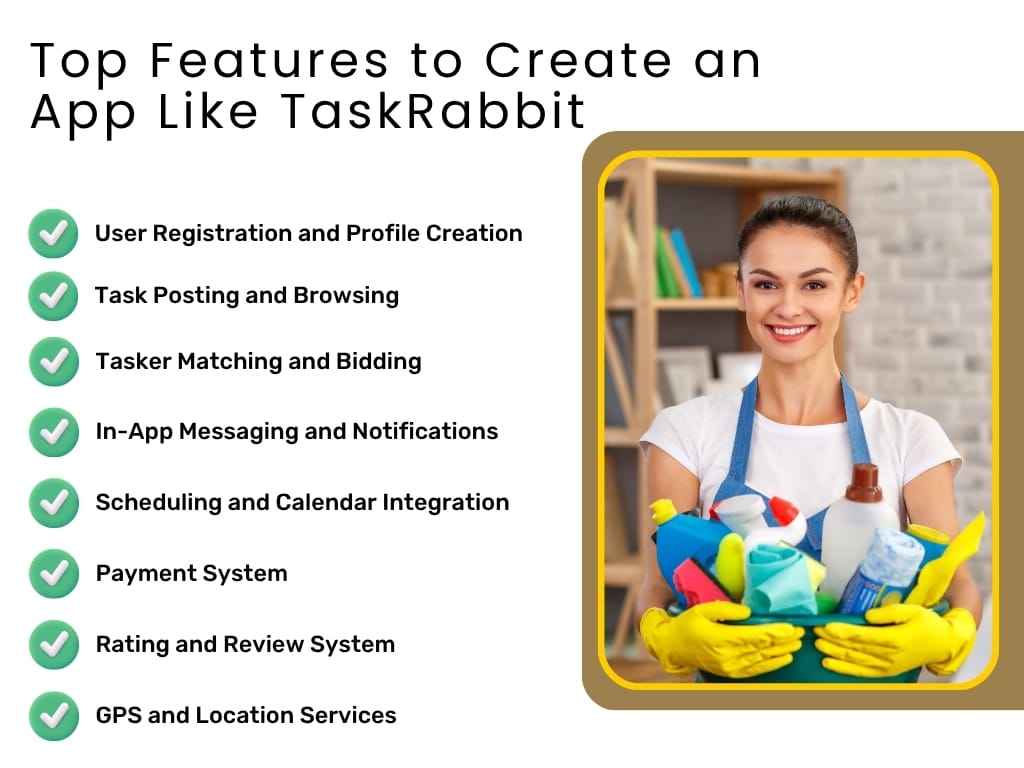
Building an app like TaskRabbit is not about copying features. It is about elevating user experience, making operations growth-friendly, and staying future-ready. Let’s explore the core features that your on-demand service marketplace must offer to be competitive in 2025 and beyond.
User Registration And Profile Creation
Allow users and service providers to sign up via email, phone number, or social logins. Include identity verification, service preferences, skills, and availability settings for Taskers.
Task Posting, Browsing, And Filters
Make task creation intuitive with categories, urgency tags, estimated budgets, and time preferences. Add filters to help users browse by ratings, skills, pricing, and proximity.
Tasker Matching And Smart Bidding System
Leverage location-based algorithms, availability tracking, and skill relevance to match users with the most relevant Taskers. Include optional bidding for competitive pricing.
In-App Messaging And Push Notifications
Enable real-time chat between users and Taskers. Add push notifications for new tasks, accepted bookings, payment confirmations, and task status updates.
Task Scheduling And Real-Time Calendar
Offer flexible scheduling with a built-in calendar view. Allow users to reschedule, cancel, or set recurring bookings with reminders.
Integrated Payments And Payouts
Securely process payments through credit cards, wallets, or UPI. Automate payouts to Taskers upon job completion with transparency in deductions and timelines.
Rating, Review, And Trust-Building Features
Allow users to rate Taskers on parameters like punctuality, professionalism, and service quality. Include verification badges and performance summaries to build trust.
Admin Dashboard, Analytics, And Support Tools
Give admins a powerful panel to manage tasks, users, disputes, and financials. Integrate advanced analytics to monitor churn, retention, service demand, and user behavior.
Multilingual And Multi-Currency Support
Serve diverse markets by offering language options and local currencies. It is highly beneficial for global scalability and inclusivity.
➡️What to Keep in Mind:
- Prioritize personalization and real-time interactions.
- Invest in seamless UI and background automation for trust and speed.
- Plan these features from the MVP stage to avoid costly refactoring later.
Core Insight: The future of on-demand marketplaces lies in frictionless user experience, transparency, and tech-enhanced convenience. Your app must offer not just features but confidence and control.
TaskRabbit App Design And UX: What Makes It So Intuitive
Have you ever opened an app and instantly felt like you knew exactly what to do next? That is the kind of user experience TaskRabbit delivers and what your app must strive for.
The brilliance of TaskRabbit’s design lies in its invisibility. Users are not overwhelmed by too many choices. Instead, the interface guides them naturally from task posting to payment without hurdles.
Here is what sets TaskRabbit’s intuitive UX apart and how you can replicate it:
Clear User Journey
From onboarding to task completion, every step is visually defined and action-oriented. Micro-interactions guide users instead of cluttering their path.
Prioritized CTAs
Bold, well-placed call-to-action buttons make it easy to post tasks, accept offers, or navigate between key screens.
Color Psychology And Typography
Soothing color palettes, readable fonts, and visual consistency foster trust and improve retention. Use contrast to highlight salient functions like messaging and payments.
Minimalist Yet Informative Layouts
Keep screens uncluttered. Surface only the most essential information while using collapsible menus or progressive disclosure for deeper actions.
Accessibility By Design
Enable voice commands, readable labels, and accessible font sizes. Inclusive design is not a feature. It is a necessity in 2025.
Fast Load Speeds And Animations
Your UI is only as good as your app’s performance. Fluid animations, instant loading, and responsive feedback give users confidence in every tap.
The Bottom Line: A sleek, user-first interface is not just about aesthetics. It builds credibility, trust, and a loyal user base. Design for clarity, not complexity.
Top 10 Best TaskRabbit Alternatives And Competitors In 2025
Looking for a fresh twist on TaskRabbit? You’re not alone. While TaskRabbit remains a solid name in on-demand home services, it no longer holds a monopoly on convenience, flexibility, or innovation. Several apps now compete for attention with superior UI, top-notch vetting systems, and niche specialties.
Here are the top 10 TaskRabbit alternatives you should know in 2025:
Handy
A go-to app for cleaning and furniture assembly. Handy focuses on simplicity and vetted professionals. Ideal for users who want swift booking without the complexity of bidding or browsing.
- Unique Edge: Streamlined booking and pre-screened service providers.
Thumbtack
Thumbtack allows users to request quotes and compare pros across a wide range of categories.
- Unique Edge: Cutting-edge bidding system and custom pricing options.
Angi (Angie’s List)
A long-standing platform for larger renovation and contractor-based tasks. Angi offers subscription access and a more traditional project scope.
- Unique Edge: Focus on large-scale projects with extensive vetting.
Porch
Porch connects homeowners with professionals for home improvement and repair services. It is heavily integrated with retailers like Lowe’s.
- Unique Edge: Built-in retail partnerships and verified contractor network.
UrbanClap (now Urban Company)
One of the leading platforms in Asia and the Middle East, offering services from beauty to plumbing.
- Unique Edge: Broad service categories and high focus on in-home services.
Zaarly
An invitation-only service marketplace that emphasizes hyper-local connections and elite service quality.
- Unique Edge: Exclusivity and focus on quality over quantity.
Jiffy
Popular in Canada, Jiffy offers quick home maintenance bookings with pre-set pricing and rapid turnaround.
- Unique Edge: Instant booking with standardized pricing.
TaskEasy
Focused primarily on lawn care and exterior home services. TaskEasy offers seasonal subscriptions and contractor tracking.
- Unique Edge: Niche market specialization with auto-renewing plans.
HomeAdvisor
A subsidiary of Angi, HomeAdvisor offers quote-based project listings with contractor reviews and financing options.
- Unique Edge: Offers flexible payment options and financing for large jobs.
Takl
Though not prominent today, Takl still serves markets with smaller home tasks and errands with upfront pricing.
- Unique Edge: Focus on smaller, quick duties with fixed fees.
A Visual Comparison of Top TaskRabbit Alternatives In 2025
| App Name | Best For | Monetization Model | Notable Strength |
| Handy | Cleaning and furniture assembly | Commission on Services | Quick booking and pre-vetted pros |
| Thumbtack | Local professionals in all trades | Quote-based and ad revenue | Smart bidding and wide service categories |
| Angi | Home renovation and contractors | Subscription and service fees | Long-form reviews and large project support |
| Porch | Home improvement services | Retail partnerships | Integrated with Lowe’s and verified pros |
| Urban Company | Diverse in-home services | Commission and subscriptions | Highly preferred in Asia with spa, repair, and cleaning |
| Zaarly | Elite, local service providers | Membership model | Invitation-only with a high-quality focus |
| Jiffy | Small repairs in Canada | Fixed price per task | Real-time booking with no quotes |
| TaskEasy | Lawn care and outdoor tasks | Recurring subscriptions | Auto-renew plans and contractor tracking |
| HomeAdvisor | Contractors and large projects | Leads-based pricing | Project financing and an extensive contractor database |
| Takl | Quick tasks and errands | Flat fee per task | Predefined task list for fast decision-making |
What You Should Know: The future of service marketplace apps lies in specialization, speed, and trust. These ten apps reflect where consumer demand is headed and offer sharp cues for building your next TaskRabbit-style platform.
How Does TaskRabbit Make Money? (And How Your Clone App Can Too)
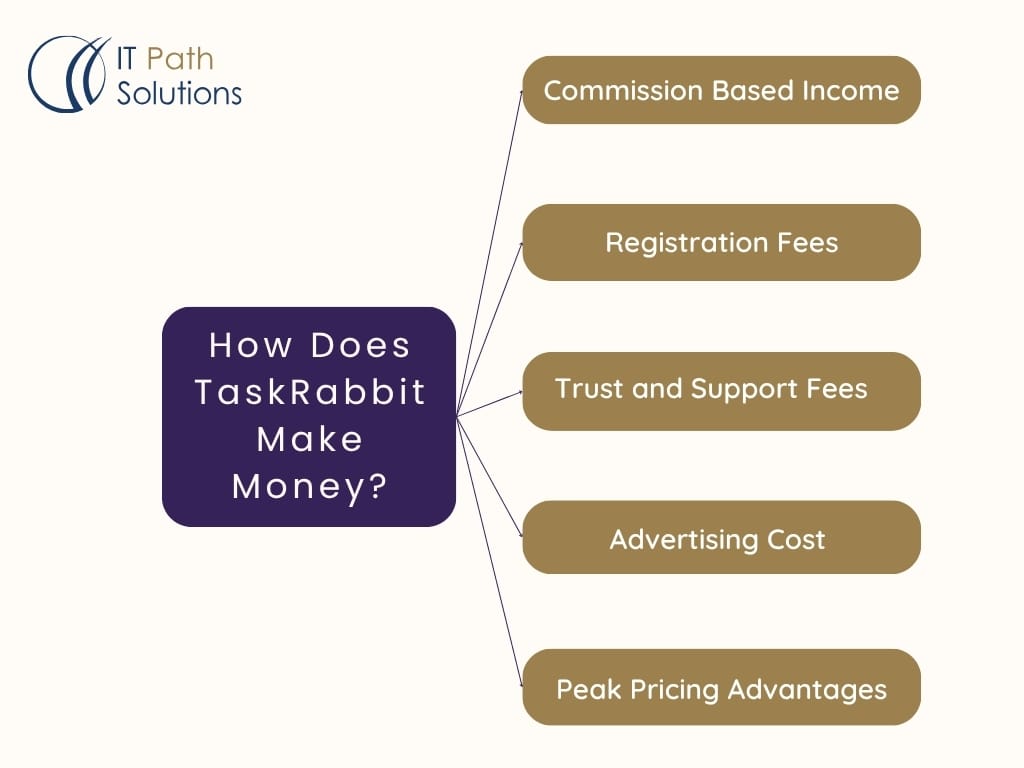
A sustainable on-demand platform needs more than just users. It needs a reliable, multi-channel revenue engine. TaskRabbit has perfected the art of monetizing micro-services, turning small tasks into scalable income streams.
Five Proven Monetization Strategies
The following are strategies that power TaskRabbit:
Commission-Based Model
TaskRabbit charges a percentage on every transaction between a Tasker and a client. It is the most consistent revenue stream and scales naturally with user growth. You can offer tiered commissions based on service categories or user ratings.
Trust and Support Fees
In addition to commissions, TaskRabbit includes a trust and support fee in the total cost. This fee covers insurance, platform safety features, and dispute resolution. It creates an added value layer for both users and service providers.
Paid Promotions
Service providers can pay for premium placement in search results. It works like ads and bolsters their visibility on the platform. You can include advanced filters for the location or niche skills to maximize relevance.
Surge or Peak Pricing
Like ride-sharing apps, TaskRabbit introduces dynamic pricing during high-demand hours or seasons. It encourages more Taskers to be available and improves service credibility without manual intervention.
Subscriptions or SaaS Access
Offering premium features to Taskers through a subscription model is another effective stream. It can include analytics dashboards, lead generation tools, or access to priority customer support.
Tips To Monetize Your Clone App Like Or Even Better Than TaskRabbit
To build a successful clone of TaskRabbit, you need monetization strategies that are flexible, user-centric, and scalable. Below are six actionable models, each broken down into practical, revenue-driven ideas.
Launch with a Freemium Model, Then Upsell
- Offer core features (task posting, browsing, booking) for free
- Lock top-tier perks behind premium plans
- Upsell verified Tasker badges, faster payouts, and priority listings
- Use free access to cultivate trust and propel engagement before conversion
Offer Smart Add-Ons And Bundles
- Introduce task bundles (e.g., cleaning + furniture assembly) at a discount
- Allow users to add convenience features (like insurance or express booking)
- Use tiered pricing to personalize service packages
- Drive a higher average order value without overwhelming users
Enable Sponsored Listings
- Let Taskers pay for top placement in search results
- Offer location targeting for maximum visibility in local areas
- Use bidding or fixed-price promotion slots
- Create rotating ad spots within task categories
Sell Business Accounts or SaaS Plans
- Offer tools for service providers to manage teams and bookings
- Include advanced analytics, branded profiles, and CRM features
- Provide monthly or annual SaaS subscription options
- Tap into B2B demand beyond individual Taskers
Earn Through Micro-Transactions
- Add tipping options for Taskers during checkout
- Charge small fees for features like instant booking or late cancellation protection
- Introduce token-based priority support or early access to new features
- Keep transaction friction low while generating consistent revenue
Integrate Referral And Loyalty Programs
- Reward users for inviting friends with in-app credits
- Offer Taskers bonuses for a repeat performance or five-star ratings
- Use tiered loyalty programs to increase retention
- Promote gamified elements to keep users engaged and returning
Your clone app can outperform basic service marketplaces with layered monetization and value-added upgrades.
Must-Know Insight: Monetizing your TaskRabbit-style app is not about adding fees. It is about offering value that people are willing to pay for. A thoughtful blend of commission, support fees, and upsells can unlock consistent recurring revenue.
How To Build A TaskRabbit-like App (Step-by-Step Process)
Creating a successful on-demand service app goes beyond writing code. It requires thoughtful planning, strategic execution, and deep empathy for both users and service providers. Below is a simplified roadmap that shows how you can transform your idea into a fully functional TaskRabbit-style app.
Step 1: Market Research And Competitive Benchmarking
Before development begins, analyze what competitors offer, what users want, and what gaps still exist. Tools like SWOT analysis and user persona mapping can guide the product direction early on.
Step 2: App Planning And Feature Mapping
Define your core features. Decide what’s essential for your MVP and what can be introduced later. Prioritize features like task creation, booking, payments, and chat.
Step 3: Designing Wireframes And UI
Focus on intuitive navigation, fewer clicks to action, and engaging design elements. Collaborate with a UI designer to develop wireframes that reflect real user journeys and common task scenarios.
Step 4: Backend Architecture And Frontend Development
Choose scalable, secure, and modular backend technologies. The frontend should respond quickly, work seamlessly across devices, and ensure minimal latency during searches, bookings, and messaging.
Step 5: Integration (APIs, Payments, Calendar, etc.)
Connect third-party services, such as payment gateways, chat APIs, location tracking tools, and calendar syncing, to offer an exceptional user experience.
Step 6: Testing, QA, And Deployment
Run multiple testing cycles. It includes functional testing, usability testing, and load testing to prepare the app for real-world usage and edge cases.
Step 7: Post-Launch Support And Optimization
Once live, gather user feedback and usage data. Use this insight to enrich features, optimize performance, and expand your user base confidently.
Smart Summary: Building a TaskRabbit-like app is not a sprint. It is a series of calculated steps, each one bringing you closer to a product that users trust, love, and return to regularly.
Best Technology Stack For TaskRabbit-like App Development
Building a TaskRabbit-like app is not just about front-end polish. Behind the scenes, a robust tech stack ensures performance, security, scalability, and speed. If your goal is to deliver an experience that is smooth for both Taskers and users, choosing the right technologies is non-negotiable.
Let’s break down the ideal tech stack for a service marketplace like TaskRabbit.
Frontend (User Interface)
- Mobile (iOS): Swift, SwiftUI
- Mobile (Android): Kotlin, Jetpack Compose
- Cross-Platform (Optional): Flutter or React Native
- Web Interface: React.js or Vue.js
Backend (Server Side)
- Programming Language: Node.js, Python, or Ruby
- Frameworks: Express.js, Django, or Ruby on Rails
- Authentication & Authorization: OAuth 2.0, JWT
- Real-Time Updates: Socket.io or Firebase
Database Layer
- Relational DB: PostgreSQL or MySQL
- NoSQL (Optional for scale): MongoDB
- Cloud Storage: AWS S3 or Google Cloud Storage
APIs And Integrations
- Maps and Location: Google Maps API, Mapbox
- Payment Gateway: Stripe, PayPal, Razorpay
- Push Notifications: Firebase Cloud Messaging, OneSignal
- Scheduling & Calendars: Cron Jobs, Google Calendar API
- SMS & Email: Twilio, SendGrid, Mailgun
Admin Panel And Analytics
- Admin Dashboard: React.js with Redux or Vue with Vuex
- Analytics Integration: Google Analytics, Mixpanel, Firebase Analytics
- User Behavior Tracking: Hotjar, FullStory
DevOps And Hosting
- Server Hosting: AWS EC2, Google Cloud, DigitalOcean
- Containerization: Docker
- CI/CD: Jenkins, GitHub Actions
- Monitoring & Logging: Sentry, LogRocket, New Relic
Essential Insight: A successful TaskRabbit-like app relies on the ideal tech stack that balances speed, security, and scalability. Select your tools based on your app’s goals, growth expectations, and long-term support needs.
How Much Does It Cost To Build An App Like TaskRabbit In 2025?
Wondering what the cost of developing a mobile app like TaskRabbit looks like in 2025? Whether you’re planning a simple MVP or a full-scale marketplace platform, understanding the pricing dynamics of mobile app development is critical to budgeting and planning ahead.
Let’s break down the cost aspects.
MVP Cost Estimate
An MVP (Minimum Viable Product) covers the must-have features like user registration, task creation, messaging, and secure payments.
-
- Estimated Range: $20,000 to $40,000
- Timeline: 8 to 12 weeks
- Team Involved:
-
- UI/UX Designers
- Backend Engineers
- QA Testers
- A project manager
Full-Scale Build Estimate
Looking for something more state-of-the-art? A full-featured TaskRabbit-style app includes AI-based task matching, real-time analytics, multi-language support, and admin dashboards.
- Estimated Range: $60,000 to $120,000
- Timeline: 16 to 24 weeks
- Best Suited For: Funded startups or businesses ready to scale their mobile app development
Cost Breakdown Of Developing A Mobile App Like TaskRabbit
| Stage | Key Features Included | Estimated Cost Range | Timeline |
| MVP Development | User sign-up, task creation, messaging, payments, reviews | $20,000–$40,000 | 8–12 weeks |
| Core Platform Build | Smart bidding, scheduling, real-time notifications, profile badges | $40,000–$70,000 | 12–16 weeks |
| Advanced Features | Analytics dashboard, loyalty programs, multi-language, and AI matching | $70,000–$100,000+ | 16–24 weeks |
| Maintenance & Scaling | Server costs, updates, monitoring, scalability improvements | $5,000–$15,000 annually | Ongoing |
Hidden Costs To Consider
- Third-Party APIs: Google Maps, Twilio, Stripe, and more
- Maintenance and Updates: Regular support, performance optimization, and security patches
- App Store Fees: Submissions to Google Play and Apple App Store
- Compliance and Security: GDPR requirements, encryption, and data protection
- Customer Support Systems: Chatbots, help desks, and ticketing tools
Knowledge Drop: The cost of developing a mobile app like TaskRabbit ranges from $20,000 to over $100,000. The final budget depends on the scope, complexity, and vision of your mobile app development journey.
Compliance, Security, And Scalability Checklist For Your TaskRabbit App
As your TaskRabbit-style app begins to scale, so do the expectations of users, regulators, and service providers. Ignoring compliance, overlooking security, or neglecting scalability can put your business at risk. Let’s explore the crucial technical and legal foundations you should cover.
Compliance Essentials
Ensuring your platform aligns with regional and global regulations fosters long-term trust and prevents legal trouble.
- GDPR and CCPA Compliance (depending on your market) for user data handling and transparency
- KYC and AML Processes for verifying Taskers and preventing fraud
- Terms of Service and Privacy Policy are written unambiguously and professionally
- Payment Gateway Compliance with PCI-DSS to safeguard financial data
- ADA and WCAG Guidelines to ensure accessibility for all users
Security Checklist
In a service marketplace where trust is currency, security is not optional. Your app must be prepared for both internal breaches and external attacks.
- End-to-End Encryption for all user communications and transactions
- Multi-Factor Authentication for both Taskers and Requesters
- Data Encryption at Rest and In Transit
- Real-Time Activity Monitoring to detect anomalies or suspicious behavior
- Regular Security Audits to identify vulnerabilities and patch them quickly
Scalability Considerations
A platform like TaskRabbit must handle dynamic user spikes, growing databases, and real-time interactions as it expands.
- Microservices-Based Architecture for seamless scaling and maintenance
- Cloud Hosting with Auto-Scaling Capabilities such as AWS, Google Cloud, or Azure
- Load Balancing and Caching Mechanisms for smooth performance during high traffic
- Optimized APIs and Lightweight Frameworks for quicker data retrieval and integration
- Database Optimization for managing large volumes of user and task data
What You Should Know: Scalability means you can grow without breaking. Security earns trust. Compliance keeps you in the game. Mastering all three builds a platform users rely on and regulators respect.
Marketing, Launch, And User Growth Strategy For TaskRabbit-Style App
You’ve built your TaskRabbit-style app. It’s fast, secure, and elegantly designed. But without users, it’s just another invisible tool. Success begins with a powerful launch and continues with a strategic growth plan.
Let’s break down how to put your app in front of the right people and build traction from day one.
Pre-Launch Strategy
- Build Buzz Early: Start with teaser campaigns on social media. Showcase what makes your app unique and why users should care.
- Landing Page for Early Signups: Collect emails from interested users and Taskers to create a waitlist before the app goes live.
- Beta Testing with Incentives: Offer volunteers (users) to test the app in exchange for feedback, perks, or early Tasker access.
Go-to-Market Plan
- Launch Day Strategy: Align PR, email blasts, influencer posts, and social campaigns on the same day to maximize impact.
- Target Local Communities First: Focus on a specific city or region to refine your service experience before expanding.
- App Store Optimization (ASO): Optimize your app listing with relevant keywords, visuals, and compelling descriptions.
Scaling And Growth Tactics
- Referral Programs: Reward both Taskers and Requesters for capturing new users.
- In-App Gamification: Introduce badges, milestones, and rewards to keep users engaged.
- Hyper-Local Campaigns: Run ads and community partnerships in neighborhoods where services are in high demand.
- Influencer & Content Marketing: Collaborate with micro-influencers and bloggers to create buzz and build trust.
- Use Analytics Tools: Monitor user behavior and iterate features based on actionable insights.
Key Takeaway: Launching your app is just the beginning. Sustained growth comes from a clear marketing vision, community-driven strategies, and data-backed decisions that keep users engaged and loyal.
Why Choose IT Path Solutions For TaskRabbit-Like App Development?
Picture this: your on-demand service platform going live, attracting users from day one, and effortlessly handling thousands of bookings without a glitch. At IT Path Solutions, we don’t just develop apps; we engineer high-performance digital ecosystems designed to grow with your ambition and scale with your success.
What Makes Us Your Launchpad For TaskRabbit-Style Success
We Turn Ideas into Impactful Apps
From MVPs to enterprise-grade platforms, our team has delivered dozens of successful on-demand service apps across industries. We translate your vision into a robust and growth-friendly product.
Launch Faster and Smarter
We use pre-built modules for login, messaging, geolocation, payments, and more. It accelerates time to market without compromising on customization or quality.
Your Brand, Your Business Model
Whether you want to monetize through commissions, subscriptions, or SaaS offerings, we customize your app to your goals. You control the experience and revenue stream.
Enterprise-Grade Security and Compliance
Our development practices follow global standards, including GDPR and PCI DSS. You stay protected while your users remain confident.
Real-Time Insights and Admin Control
From user tracking to performance analytics, we equip you with a powerful backend that helps you make data-driven decisions.
Support Beyond Launch
We offer post-launch optimization, updates, feature enhancements, and 24/7 support. It ensures your app evolves with your business.
Strategic Opportunities with IT Path Solutions
- Launch in niche verticals with less competition but high demand.
- Build multi-city or multi-country operations with multilingual and multi-currency features.
- Integrate AI-driven task matching or savvy scheduling for an elevated user experience.
- Add admin-level automation to streamline business operations and reduce manual tasks.
In a Nutshell: Working with IT Path Solutions means you don’t just build an app like TaskRabbit. You craft a future-ready platform, backed by experts, designed for success from day one.
Conclusion
The rise of the on-demand economy has redefined how people access services, solve problems, and earn a living. As consumer behavior shifts toward instant gratification and trust-based local services, there has never been a better time to build your own service marketplace.
Whether you’re targeting home repairs, pet sitting, wellness, or a niche market, a TaskRabbit-style platform can empower your users and create a consistent revenue stream for your business.
Throughout this guide, you have learned how TaskRabbit works, what makes it successful, what features you need, and what it takes to turn an idea into a fully functional product. From technology stack to monetization strategies and cost estimations, you now have the blueprint to move forward.
If you are passionate about launching a robust and future-ready on-demand mobile app solutions, partnering with a skilled mobile app development team makes all the difference.
At IT Path Solutions, we transform your vision into a user-loved, growth-driven app with precision, scalability, and speed. Let’s build something that outlasts trends and becomes the next big success story.
Your marketplace revolution starts here. The opportunity is lucrative, the tools are ready, and the future is yours to shape.
FAQ
How Do I Validate My TaskRabbit-Like App Idea Before Development?
Begin with market research, surveys, and MVP testing. Use landing pages and waitlists to assess demand. Analyze competitor reviews to identify gaps. Validation helps avoid costly mistakes and ensures you build what users truly need.
What Are The Legal Requirements For Launching A TaskRabbit Clone?
You must adhere to labor laws, privacy regulations, and payment handling standards in your target region. Consider terms of service, liability waivers, and user agreements. Consulting a legal expert during early planning is highly recommended.
Can I Monetize A TaskRabbit-Style App Without Charging Taskers Directly?
Yes. You can earn through premium listings, featured placements, advertising, SaaS models for agencies, or referral partnerships. Offering value-added services also opens additional revenue streams without directly taxing Taskers.
How Do I Handle Disputes Between Users On My Service Marketplace App?
Implement a robust in-app dispute resolution system. Offer real-time support, transparent policies, and an escalation process. Automated documentation tools and review systems can help verify and resolve user claims fairly.
Is It Possible To Launch A TaskRabbit Clone Without A Tech Background?
Absolutely. Partnering with an experienced development company like IT Path Solutions allows non-technical founders to focus on growth and strategy while experts handle development, design, and deployment.
What Makes TaskRabbit Different From Handy Or Thumbtack?
TaskRabbit focuses on quick, local task fulfillment with instant booking, real-time tracking, and flexible gig options. Handy is more service-provider-driven with scheduled cleanings and installations, while Thumbtack enables bidding across broader project scopes.
Each serves different user needs based on service depth, pricing model, and engagement style.
What Does It Cost To Make A TaskRabbit App?
The cost to build a TaskRabbit-style app ranges from $25,000 to $150,000. It depends on features, tech stack, platform choices, and development scope. MVP versions are cost-effective, while full-scale apps with AI features, admin dashboards, and advanced security cost more.

Keyur Patel
Co-Founder
Keyur Patel is the director at IT Path Solutions, where he helps businesses develop scalable applications. With his extensive experience and visionary approach, he leads the team to create futuristic solutions. Keyur Patel has exceptional leadership skills and technical expertise in Node.js, .Net, React.js, AI/ML, and PHP frameworks. His dedication to driving digital transformation makes him an invaluable asset to the company.

